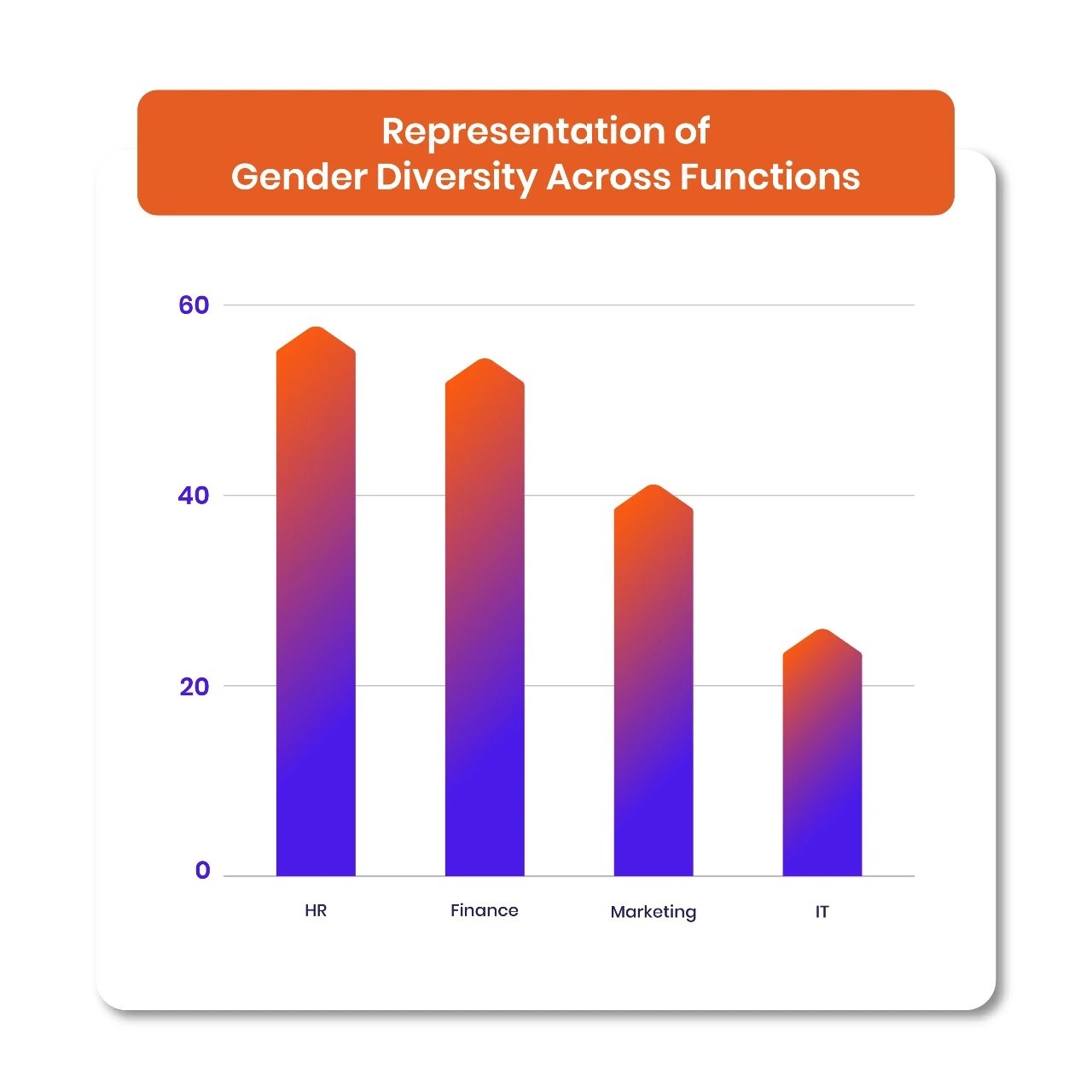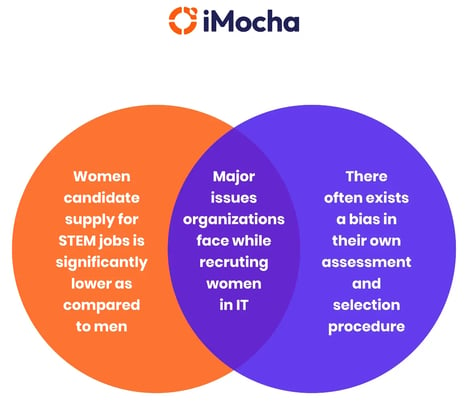Women at work make up almost half of the global workforce; however, only 28% of them represent the IT industry (according to a recent Gartner report).
A number of reasons have led to this shortfall: women are twice as likely to quit their tech jobs as compared to their male peers, IT is the second to last function when it comes to women representation, and, most importantly, recruiting process deters women as often unconscious bias prevails in all steps of the hiring process: interviews, even job descriptions.
And while we have identified the shortfalls that lead to this unassuming gender recruitment gap, we’d be remiss if we didn’t acknowledge the concern senior leaders and C-suite has expressed about this glaring issue. They realize that a balanced workforce with equal representation has been linked to innovation; moreover, organizations with high or equal gender balance have been more profitable.
 Various studies about women at work suggest that the overall satisfaction level of employees is low in organizations with less or poor women representation in technology. Many organizations have started tracking the number of women in the workforce and setting targets for female recruitment and retention.
Various studies about women at work suggest that the overall satisfaction level of employees is low in organizations with less or poor women representation in technology. Many organizations have started tracking the number of women in the workforce and setting targets for female recruitment and retention.
So here are a few focus areas for you to consider while making efforts to hire more women in technology:
Focus Area 1: How to Mitigate Gender Bias in Female Recruitment
IT recruitment usually follows a pattern. Most, if not all, organizations follow a particular method of sourcing, selection, and conversion, and that method often fails to attract women.
Major issues that organizations face during gender recruitment in IT:

However, these challenges can be eradicated with appropriate measures.
- Restructuring Job Requirements:
Few preliminary and common questions that are asked while creating a desired candidate profile are: What are the expected minimum qualifications? Which skills are imperative for the role? How many years of experience are desired? Which certifications, if at all, are expected from the candidate?
And while these questions do help in creating a skeletal frame of the desired candidate, it leads to narrow results. With these requirements in mind, recruiters and talent acquisition professionals will follow the same sourcing, selection, and conversion pattern, leading to the same results.
So you can restructure these job requirements to attract women candidature. You can create an adjacent female requirement structure; one that not only challenges the previously established hiring pattern but also expands the female candidate pool. Here are some ways you can create an “adjacent” requirement structure.
- Tenure readjustments: According to a recent 'Women in Leadership Statistics Report' by the US Labor Statistics Workforce study, 45% of women with children face a career interruption — this figure is stark in comparison to men, as 23% of men in the workforce have a significant career interruption.
This statistic shows that women in technology are almost twice as likely to have non-linear career progressions as compared to their male peers. So organizations can decide whether they can decrease tenure specifications in order to increase the female candidate pool. - Education-based readjustments: Oftentimes, women at work in IT come from non-traditional backgrounds. So, when possible, you can also consider “adjacent” degree programmes with similar skill sets while hiring in your IT department.
For example, the ratio of gender representation in computer science degree programs in 2020 was 82:18 (in favor of men). However, the gender representation in the Math program was 57:43 (in favor of men). And while men do represent the bigger pool in both the education programmes, the representation of women in the latter is significantly better.
So you may consider exploring non-traditional backgrounds and establishing a robust L&D plan to increase the representation of women in technology. - Industry-based readjustments: Ask yourself, what makes your industry appealing? What exactly are the factors that set you apart? You can use this information to target women from other industries who have worked in similar roles. For instance, women have higher representation in the healthcare industry, you can target women in healthcare to move to insurance.
Focus Area 2: How to Ensure Gender Diversity in Job Descriptions and Advertisements
When you read words like ‘coding ninja’ and ‘all stack rock star’, what image is created in your mind? We don’t believe we need to answer that.
The encoded, unconscious bias in job descriptions is also a major deterrent for women to apply for job roles they may be suited for. Using terms like ‘coding ninja’, ‘rock star’, etc. signals to women that organizations are looking for a male candidate or that the organizational culture will be hostile towards women.
Moreover, a number of studies show that women are more likely to undermine their skills and qualifications, making them more deterred to applying for jobs that have overly specific job requirements. For example, if you have listed a long list of necessary qualifications, expectations, and technical skills that will be required, women may not feel confident to apply. Whereas, the same studies show that men will apply for the same jobs even if they meet 60% of the criteria.
Progressive hiring managers, recruiters, and decision-makers must realize that there is an inherent difference in the way men and women talk about themselves — women respond positively towards words and phrases that evoke empathy and care and men respond to words and phrases that are associated with ambition and competition. So organizations need to revise their language in a more female-friendly manner and emphasize factors that appeal to women, for example, flexible work timings and respect.
A great example of how changing language helped the representation of women in technology is Adidas.
Adidas created this video to demonstrate what life for women in IT means. In this video, you can see a number of executives talking about their work life and passions and how Adidas has bolstered their work. In addition to this video, Adidas created a tool-kit that made the job postings more female-friendly, which included using collaborative language and inclusive pronouns (They/them instead of gendered he/she). The org also ensured that female leaders are involved in all IT-based job advertisement writing processes, especially when the priority is female recruitment, to make sure there is no gender bias. You can also use free tools like Gender Decoder and Total Job's Gender Bias Decoder to ensure there is no unconscious bias in your job advertisements.
To know more about female recruitment and creating a safe environment for women at work, check out How to Identify and Curb Behaviour that Marginalizes Women at Work.
|
The world of recruitment is always in a flux. Learn everything you need to stay ahead of the curve. |

